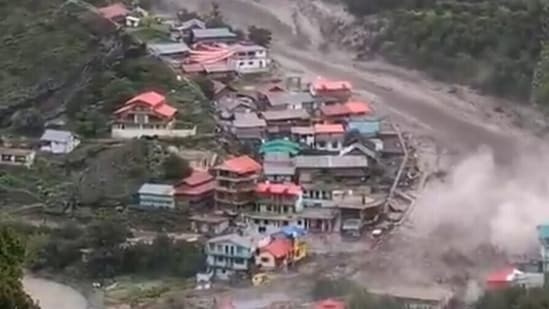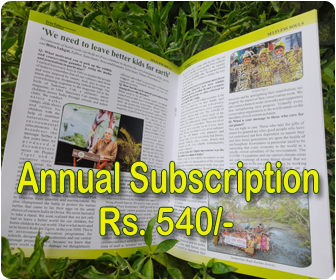Expert Expressions
Dr CP Rajendran is an adjunct professor at the National Institute of Advanced Sciences, Bengaluru, and co-author of the book: The Rumbling Earth – The Story of Indian Earthquakes
The debris flow and flash flood that occurred in Uttarkhand’s Uttarkashi district on August 5, at around 1:30 pm, which razed a village of Dharali and buried scores of people, is yet another reminder of the Himalayan meltdown that we have been witnessing for several years. Many experts believe that the Dharali disaster was caused by the bursting of glacial ponds at the headwater region of the Kheer Ganga River, which merges with the Bhagirathi at the confluence near Dharali, ruling out the possibility of a cloud burst. This disaster and previous ones in Uttarakhand and the neighbouring states highlight the increasing vulnerability of Himalayan settlements to such disasters and the potential role of human activity in exacerbating the damage potential.
Earlier, Dharali village was mostly agricultural land, then suddenly new settlements and buildings started coming up to tap the tourism potential on the riverplains without heeding any land use norms. The Dharali debris flow was a disaster in the making and is part of a continuing sequence of disasters in the Himalayan states in recent years that have become severe and frequent due to human modifications of natural systems.
The ecological imbalance and deteriorating environmental conditions have led to serious natural disasters over the years. It is reported that the authorities have ignored repeated warnings issued by the experts and violated the eco-sensitive zone. In the analysis titled “Dharali Disaster: An Echo of Himalayan Vulnerability and Human Failure in Bhagirathi Eco-sensitive Zone”, prepared and submitted to the Government by Hemant Dhyani and Navin Juyal, the potential for such types of disasters has been flagged and pointed out the violations of the Bhagirathi Eco-Sensitive Zone (BESZ) notification. The notification banned construction within 100 meters of the river’s midline and prohibited infrastructure on steep slopes without a detailed environmental assessment. The analysis said that Dharali’s constructions have been built at the stream’s edge on unstable debris fan deposits, in violation of the state’s Flood Plain Zoning Act, Namami Gange notification and National Green Tribunal guidelines. The analysis flagged the Char Dham road widening project that goes through BESZ stretches, which has compounded slope instability by cutting through old landslide debris. The road widening project has marked nearly 6000 mature deodar trees for felling between Jhala and Jangla, thus creating chronic landslide zones and a higher risk of landslides and lake outbursts. This report also recommended halting of constructions in floodplains and unstable slopes, and sustainable road designs be adopted in fragile terrains. The report warned that “Unless we stop treating fragile valleys as sites for unregulated construction and poorly planned highways, disasters like Dharali will only grow in frequency and severity”.
The scathing observations made recently by the Supreme Court of India reflect the essence of escalating environmental challenges in the Himalayas. Several grave concerns have been flagged by many experts – the “visible” and “alarming” effects of climate change, deforestation, hydropower projects, reportedly leading to water shortages and landslides; unchecked tourism impacting the ecological balance and straining resources; and continuous construction of four-lane roads, tunnels, and multi-storey buildings to accommodate the increasing number of visitors. "The day is not far when the entire state of Himachal Pradesh may vanish”, said the Supreme Court on August 01, 2025, as it sounded an alarm on the deteriorating environmental conditions in the state that has borne frequent disasters like landslides and floods with heavy loss of human life. The bench was hearing a hotel group’s challenge to a Himachal Pradesh High Court order that restricted constructions in an area declared as a green zone by the State’s Town and Country Planning Department in June.
The environmental guidelines are being blatantly violated across the entire Himalayan region, whether in the construction of roads or hydroelectric projects. As the court noted, the emerging threats to the Himalayan environment, caused by the government’s enthusiasm for extensive infrastructural projects based on the flawed assumption that this kind of development, unsuitable for the mountainous terrain already suffering from climate change, would stimulate economic growth and revenue collection. Many experts have warned that such unscientific infrastructural expansion will result in catastrophic environmental damage and significant financial losses over time. Whether in Kashmir, Himachal, or Uttarakhand, India’s annual high-altitude pilgrimages to Himalayan shrines are marked each year by numerous hazardous incidents that often lead to heavy loss of life.
The long-term sustainability of Himalayan dams also remains uncertain, as hydropower relies on a steady water supply. For instance, the Rishi-Ganga Valley disaster in February 2021 claimed over 200 lives as the river turned into a flood carrying a heavy load of silt and debris, destroying hydropower projects along its course. On October 4, 2023, a similar disaster hit Sikkim in the early hours, resulting in at least 55 deaths, with many more reported missing and thousands of people displaced. The floodwater flowing into the Teesta River in Lachen Valley was so intense that it washed away several bridges and roads, causing part of the Teesta-III Dam in Chungthang, Sikkim, to give way.
Increased glacial melt initially raises river flow due to more meltwater, but ultimately, it can result in decreased flow in the long run as glaciers shrink or potentially disappear. Climate change models forecast the cascading effects of global warming on the Himalayan glaciers, which are the main water source. Temperatures across the region are expected to rise by 1 ºc to 2 ºc on average by 2050. As glaciers retreat and seasons alternate between floods and droughts, seasonal river flows will be affected. A crucial factor is the presence of sediment hotspots in paraglacial zones; during a cloudburst, these zones release large amounts of debris and silt into the rivers, increasing their volume and causing downstream devastation.
It is essential to remember that the unique Himalayan landscape—characterised by steep slopes and sharp gradients—is not inherently suitable for human engineering. These landscapes are dynamically diverse, with properties such as climate variables, hydrological processes, and biodiversity constantly changing. Any human-induced modifications to these ecological parameters will impact stream runoff and erosional or depositional processes.
As the Supreme Court noted, subsurface structures such as tunnels can cause environmental damage, including the retention of pollutants from traffic exhaust. This issue worsens in long-distance tunnels due to the absence of sunlight and limited dispersion. Blasting often weakens rock formations, further increasing the risk of landslides and generating large quantities of excavated waste. The irreversible effects on groundwater levels, observed during tunnel construction, are cause for concern, as excavating induces stress changes and deformation within rock formations, heightening landslide vulnerability. The land subsidence seen in Joshimath and other towns serves as a warning of what could lie ahead if precautions are not taken. Concerns over the deteriorating environmental conditions in the Himalayas call for a transformative approach to development and sustainability—one that prioritises environmental protection and ecological balance, while conserving irreplaceable natural resources.















Leave a comment